LG G2 and MSM8974 Snapdragon 800 - Mini Review
by Brian Klug on September 7, 2013 1:11 AM EST- Posted in
- Smartphones
- LG
- Mobile
- LG G2
- Android 4.2
- MSM8974
- Snapdragon 800
GPU Performance
Snapdragon 800 features Qualcomm's Adreno 330 GPU. Qualcomm hasn't stated publicly how Adreno 330 compares to Adreno 320 featured in Snapdragon 600, but it's almost certainly a larger GPU. The 8974 implementation in LG's G2 clocks the Adreno 330 GPU at a maximum of 450MHz, yet we see better performance than the 450MHz Adreno 320 in Snapdragon 600 - lending credibility to the idea of having more execution resources. There's also an 8974AB variant which includes a 100 MHz bump in GPU clocks up to 550 MHz.
3DMark
3DMark for Android features the Ice Storm benchmark and uses OpenGL ES 2.0. Ice Storm is divided into two graphics tests and a physics test. The first graphics test is geometry heavy while the second test is more pixel shader intensive. The physics test, as you might guess, is CPU bound and multithreaded. The overall score takes into account both graphics and physics tests. The benchmark is rendered to an offscreen buffer at 720p/1080p and then scaled up to the native resolution of the device being tested. This is a very similar approach we've seen by game developers to avoid rendering at native resolution on some of the ultra high resolution tablets. The beauty of 3DMark's approach here is the fact that all results are comparable, regardless of a device's native resolution. The downside is we don't get a good idea of how some of the ultra high resolution tablets would behave with these workloads running at their native (> 1080p) resolutions.
For these benchmarks we stuck with the default presets (720p, normal quality).
3DMark performance generally fell very close to Qualcomm's MSM8974 MDP/T, with one exception. The CPU bound physics tests had the G2 far lower down the list than I would've expected. Given that test is mostly a multithreaded CPU benchmark, it's entirely possible that the G2's thermal/frequency governors are set more conservatively there. The performance gains elsewhere over Snapdragon 600/Adreno 320 are huge, but 3DMark can be very influenced by CPU performance so it's not clear how much of this advantage is due to Adreno 330 or Krait 400.
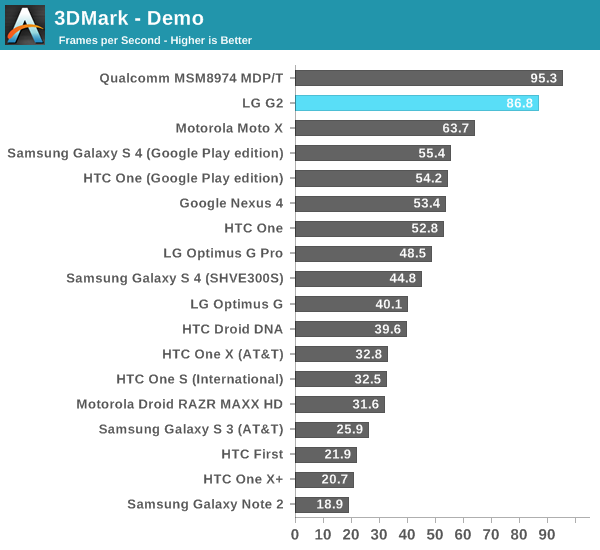
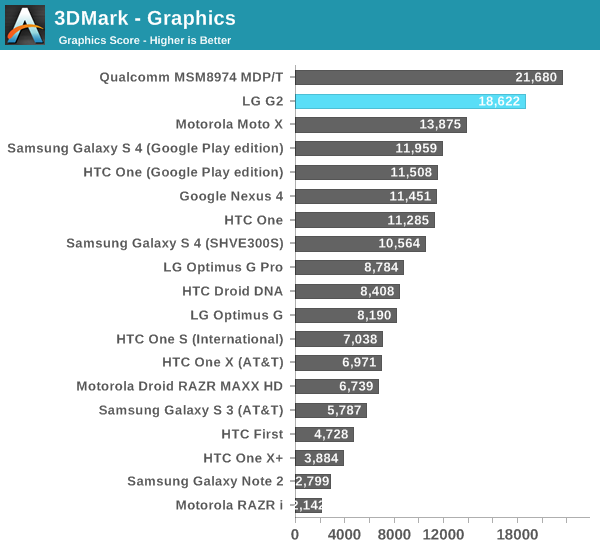
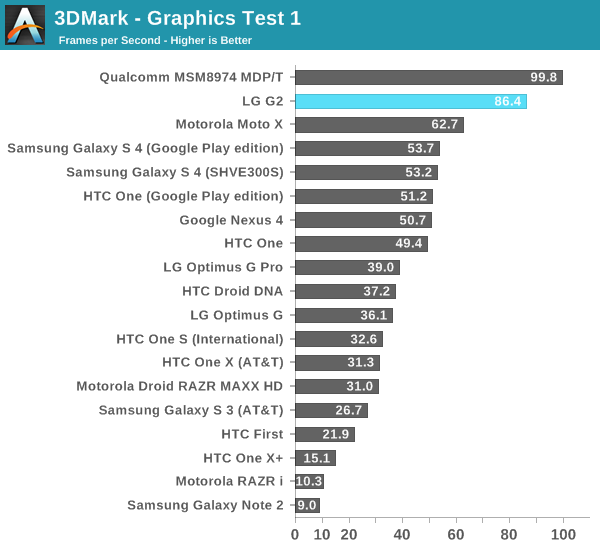
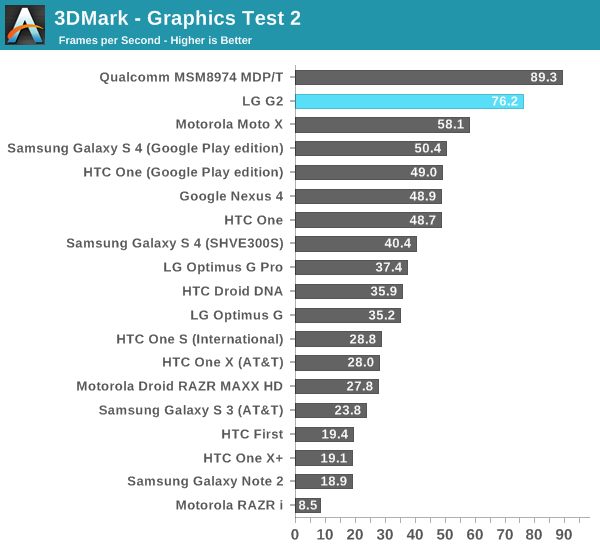
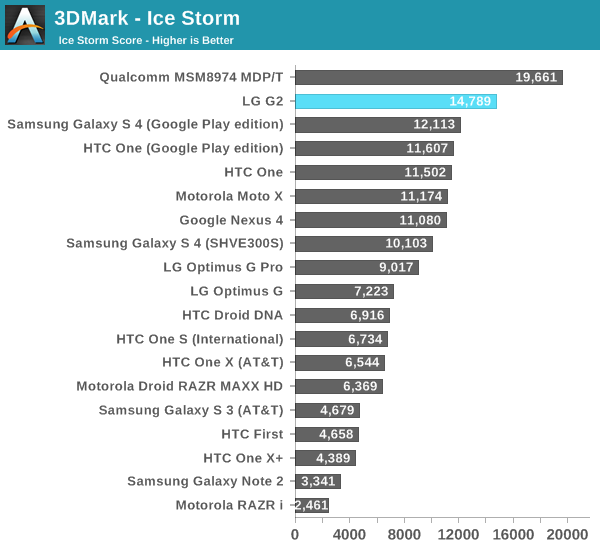
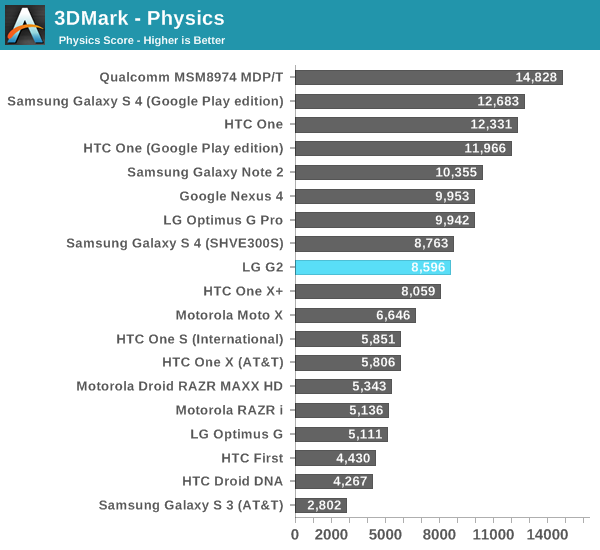
GFXBench 2.7
GFXBench (formerly GLBenchmark) gives us some low level insight into these platforms. As usual, we'll start with the low level tests and move onto the game simulation benchmarks:
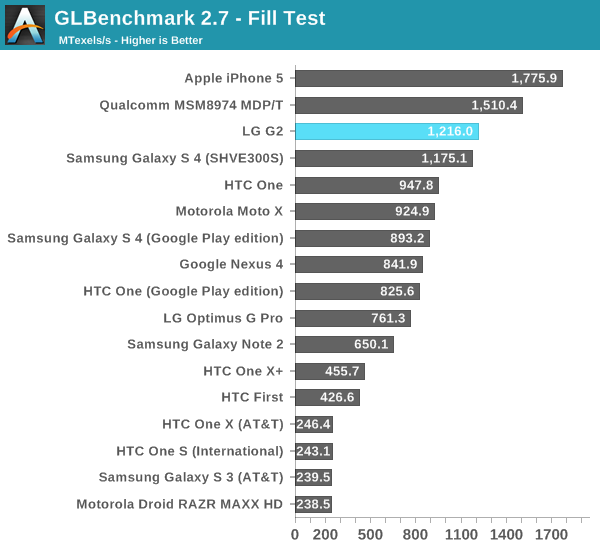
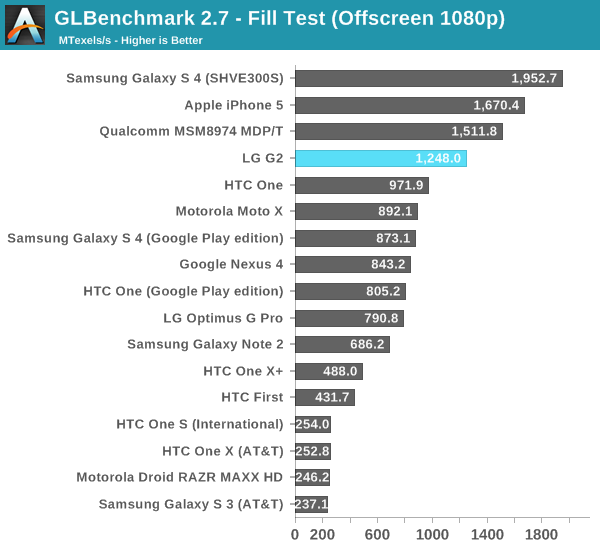
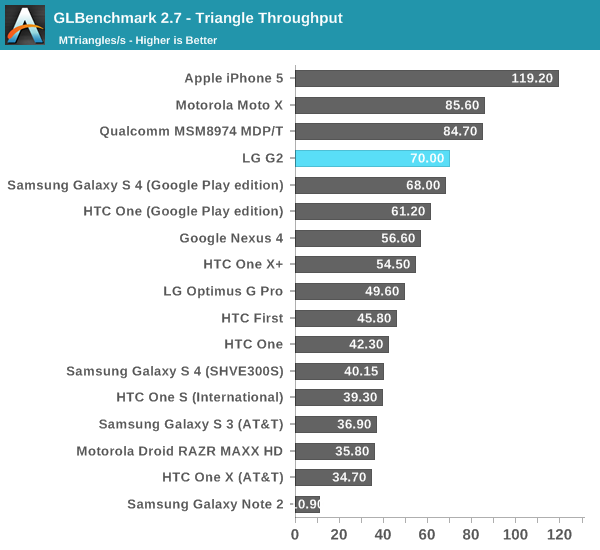
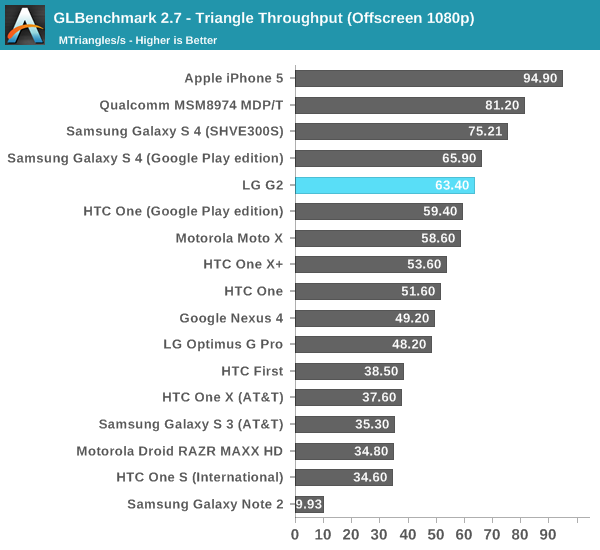
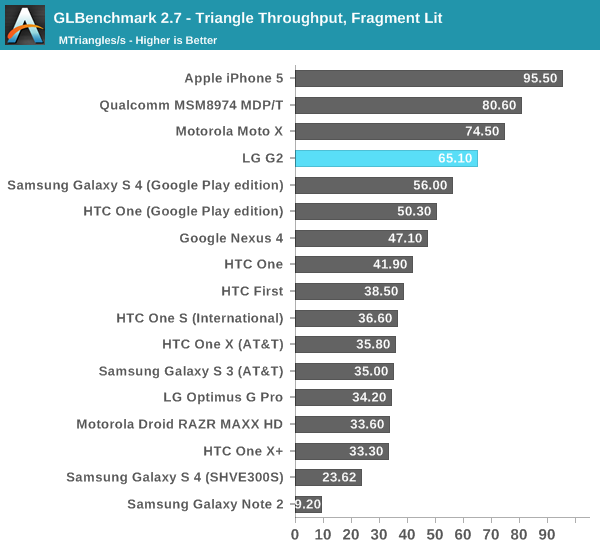
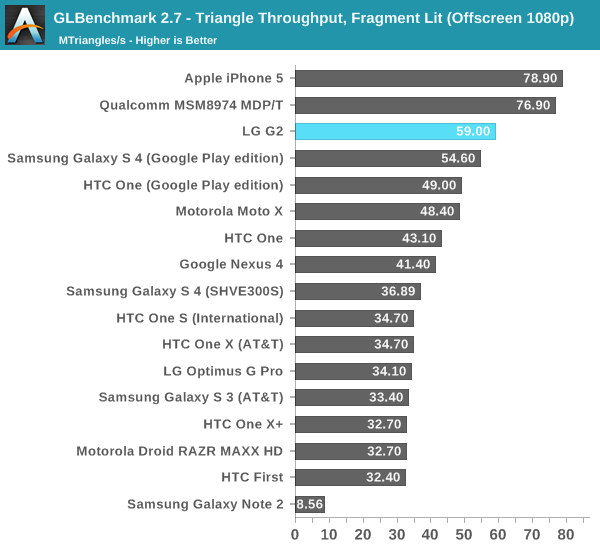
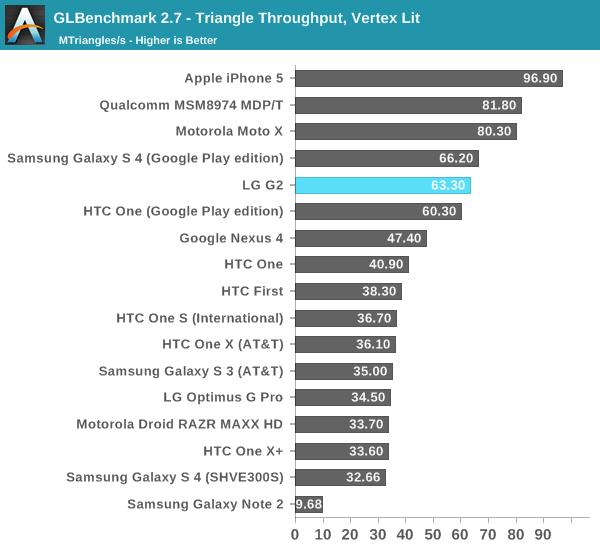
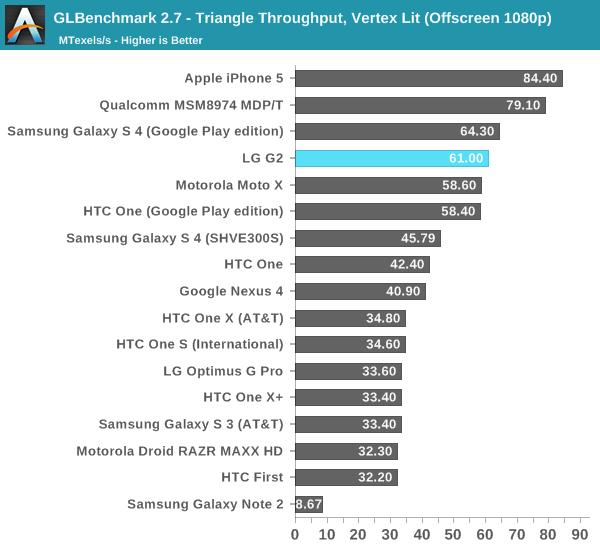
The low level tests put the G2 closer in performance to some of the Snapdragon 600 based devices than the MDP/T, again early software at work here. The T-Rex HD performance looks pretty good, putting the G2 between the S600 devices and S800 MDP/T.
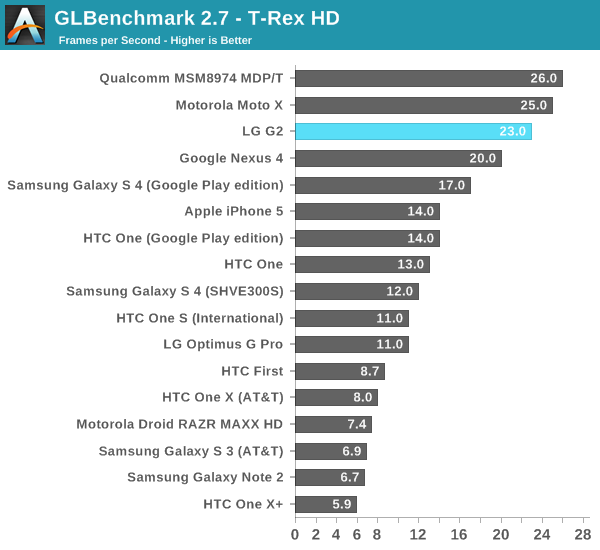
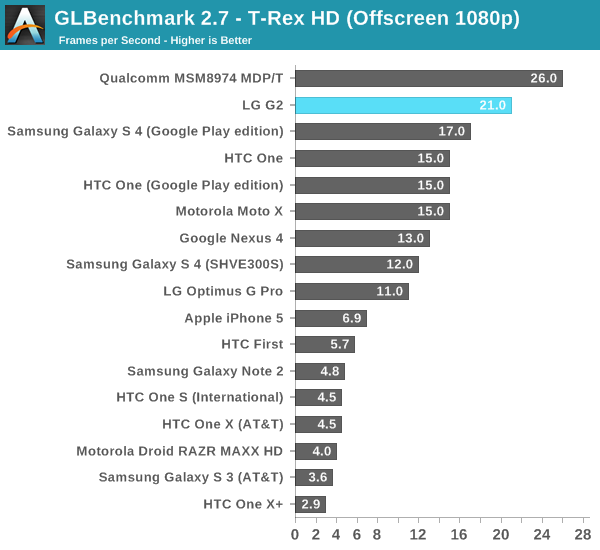
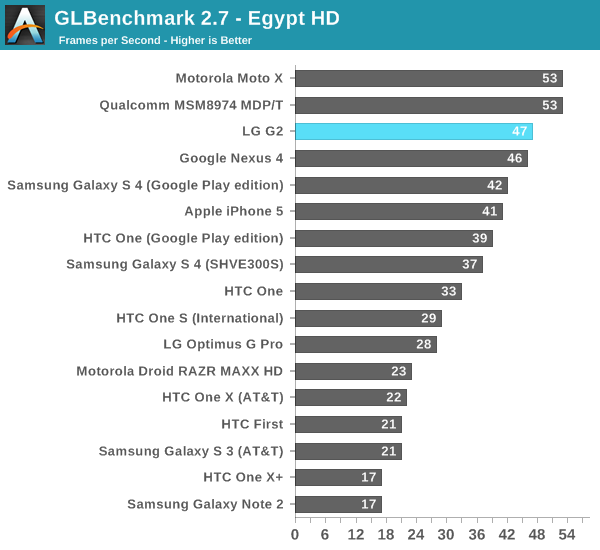
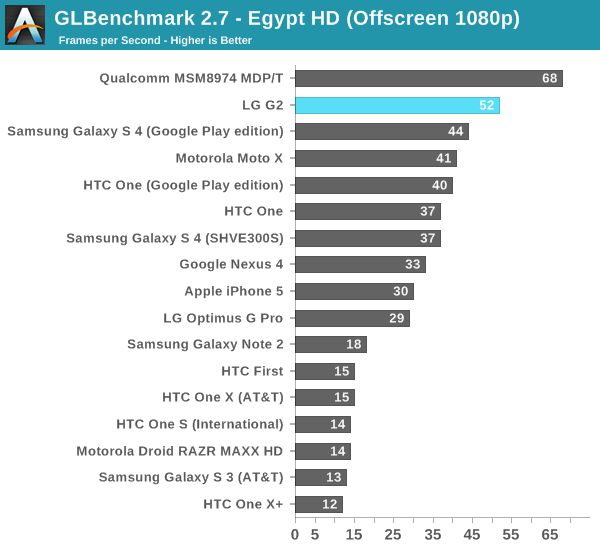
Basemark X
Basemark X is a new addition to our mobile GPU benchmark suite. There are no low level tests here, just some game simulation tests run at both onscreen (device resolution) and offscreen (1080p, no vsync) settings. The scene complexity is far closer to GLBenchmark 2.7 than the new 3DMark Ice Storm benchmark, so frame rates are pretty low:

Basemark X performance tracks with what we saw in the GFXBench T-Rex HD test. Performance is clearly higher than on any other device, but not quite up to MDP/T levels. I wonder how much closer the final device will get.
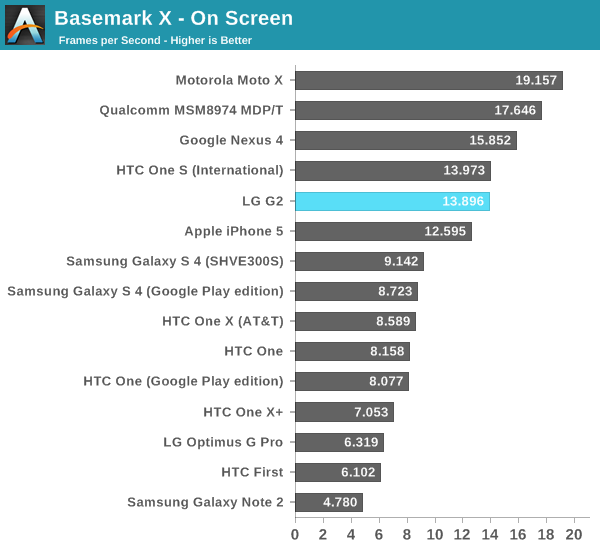
Epic Citadel
Epic's Citadel benchmark gives us a good indication of lighter workload, v-sync limited performance at native resolution. At 1080p, the Snapdragon 800 MDP/T offers over 50% better performance than the Snapdragon 600 based platforms. Granted we're comparing to smartphones here so there's some thermal advantage playing to the 800's favor.
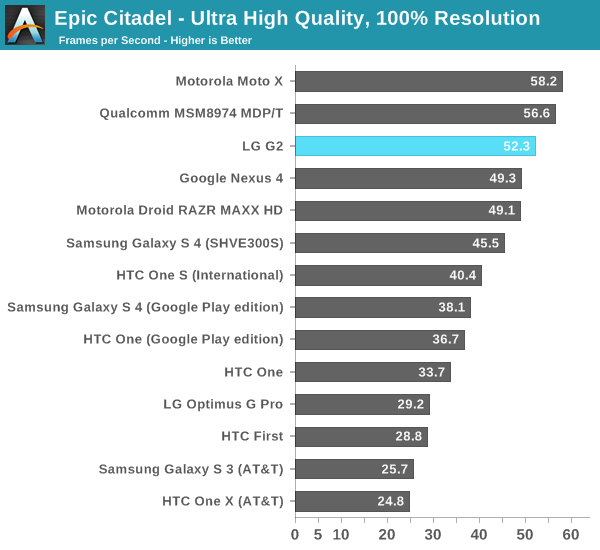










120 Comments
View All Comments
Crono - Saturday, September 7, 2013 - link
I'm surprised this qualifies as a "mini" review (even for AnandTech), but I'm impressed by the graphics performance of the G2 more than anything else. I'm just wondering if there are any applications or games yet that can take advantage on Android.fteoath64 - Saturday, September 7, 2013 - link
The graphics benchmarks put the Moto-X in a strong position een though it uses the older cores and newer Adreno 320 gpu. Granted it has only 1280X720 resolution, the overall performance is very close to the S800 with FullHD screens. This actually means that the Moto-X SoC is well optimized for it purposes. It also seems to beat the SGS4 in most graphics tests.Krysto - Saturday, September 7, 2013 - link
The test was done at 720p - for everyone - which means Moto X is beating most everyone else in GPU performance - at the same resolution. If you take the real world case, and put the others at their native 1080p resolution, then in the real world Moto X will be 2x better in gaming performance since it will push half the pixels.Also Adreno 320 is not new. Is a year old, just like the S4 Pro CPU cores. Just because S4 and HTC One used the same GPU this year, doesn't mean it's "new".
coolhardware - Saturday, September 7, 2013 - link
Pretty nice point!A question though, do any Android games render at a lower resolution and then upscale to fit native resolution?
Also, the LG G2 comes in about 6th place in top pixel density of phones
http://pixensity.com/list/phone/
and it has the largest screen of those top 6 phones... #7 Lenovo / #8 Sony are bigger though :-)
Looking forward to the final review and seeing LTE performance!
nerd1 - Saturday, September 7, 2013 - link
All the pixel density fad is apple's clever ploy to conceal their small screen. Resolution / size = density, so smaller screen will get higher dpi. However, it is quite obvious that if resolution is the same, larger screen is much easier on eye.FwFred - Saturday, September 7, 2013 - link
Agreed, we are well into the point of diminishing returns with PPI on high end smartphones. I'd imagine we are getting to the point where we are wasting power/performance for spec chasing.theduckofdeath - Sunday, September 8, 2013 - link
RR3 doesn't render in 1080p on the GS 4, I can clearly see pixelation in the 3D parts. I guess it might be because they're perhaps lazy in utilizing multi-core hardware? Because the game lags considerably when there are a lot of AI cars in front of you.warisz00r - Saturday, September 7, 2013 - link
If the next Nexus phone is indeed based on this, then color me very stoked.Panickd - Sunday, September 8, 2013 - link
Maybe loosely "based on". According to the FCC paperwork the Nexus 5 has a display of roughly 4.96 inches to the G2's 5.2 inches. Looking at the pictures the camera is also in a different place on both as well. Not huge differences, mind you, but seems like a lot of work going into making them different if they are indeed based on the same general design.I would plunk down for a G2 in a heartbeat if LG didn't have such a shoddy support and update record for their phones. I currently own an old G2x and am currently scanning around for it's successor. I'll have to wait to see what the Nexus 5 really turns out to be, I suppose.
Impulses - Sunday, September 8, 2013 - link
I'd take the smaller display and battery if it comes with a slightly better looking/feeling build (more Moto X and less Galaxy S).